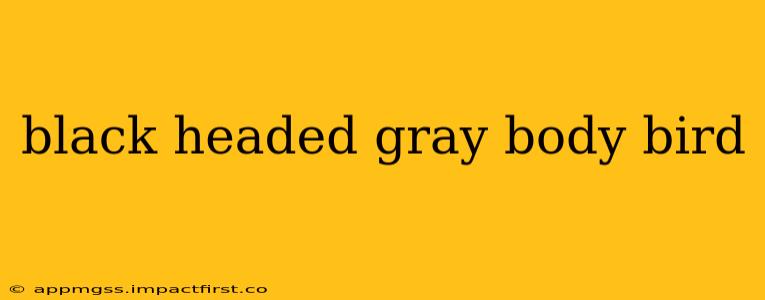Many bird species share similar color patterns, making identification a fun challenge for birdwatchers of all levels. A description like "black-headed gray body bird" could apply to several species, depending on geographic location and other identifying features. This guide will help you narrow down the possibilities and learn how to accurately identify the bird you've spotted. We'll explore various possibilities and address common questions bird enthusiasts have when encountering this type of plumage.
What kind of black-headed gray-bodied bird is this?
This is the crucial question! To accurately identify your bird, we need more information. Consider these factors:
- Location: Where did you see the bird? Knowing the region (country, state, even a specific park) significantly narrows down the possibilities. Many birds have regional variations.
- Size: Was it small, medium, or large? Compare it to familiar birds like robins, sparrows, or crows to get a sense of scale.
- Behavior: What was the bird doing? Was it foraging on the ground, perching in a tree, or flying? Its behavior can offer valuable clues.
- Other markings: Did it have any other distinguishing features? White wing bars, a specific tail pattern, a particular beak shape, or any other unique markings can be critical for identification.
- Habitat: Where was the bird located? Fields, forests, wetlands, urban areas—each habitat supports different bird species.
What are some common black-headed, gray-bodied birds?
Several bird species fit this general description, and we'll look at a few examples:
-
Northern Mockingbird (Mimus polyglottos): While the head isn't entirely black, it has a dark gray cap and a gray back. They are common in North America and are known for their exceptional vocalizations.
-
Black-headed Grosbeak (Pheucticus melanocephalus): This bird is a striking example, with a bold black head contrasting against a gray-brown body, particularly noticeable in females. Their size and habitat (often near water) are further identifying markers.
-
Some flycatchers: Several flycatcher species may show a dark head and grayish body. However, precise identification usually requires observing details like wing bars, tail patterns, and behavior. Different flycatchers also have different geographical ranges.
-
Specific subspecies and juveniles: Many bird species exhibit variations in plumage depending on age (juveniles often have different coloration) or subspecies, making a definitive identification tricky without additional information.
How can I identify a bird based on its color?
Color is a valuable starting point, but it's not always enough on its own. You'll need to consider the other factors mentioned above: location, size, behavior, other markings, and habitat. Using a field guide or a bird identification app that takes these factors into account will greatly improve your chances of successful identification.
Are there any online resources to help me identify birds?
Yes! Many excellent online resources can assist you. Consider using:
- Online bird identification guides: Several websites offer detailed information and images to aid in identification. Use keywords like "bird identification" along with descriptive terms, like "gray body black head bird."
- Bird identification apps: Mobile apps often use image recognition technology or guided identification features to help determine a bird's species.
- Local birdwatching clubs or organizations: These groups often have experienced birders who can provide assistance with identification.
Remember, accurate bird identification often requires a combination of careful observation and the use of reliable resources. Don't get discouraged if you can't immediately pinpoint the species; keep practicing, and you'll become increasingly adept at identifying birds based on their unique characteristics.
